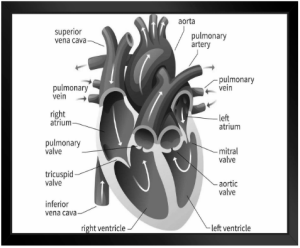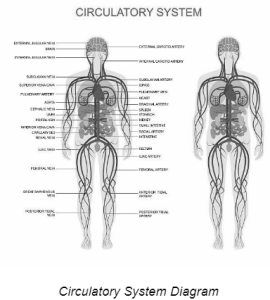The circulatory system, alternatively referred to as the cardiovascular system, comprises the heart and blood arteries. It is responsible for transporting oxygen and other nutrients to all of your body’s organs and tissues. Additionally, it is capable of removing carbon dioxide and other waste products.
A healthy circulatory system is critical for your overall health and well-being. Continue reading to learn more about the circulatory system, its function, and what you can do to maintain a healthy heart and blood vessels.
Components of circulatory system
Circulatory system is composed of the following components:
- The heart, a muscular organ responsible for the circulation of blood throughout the body.
- Arterioles, veins, and capillaries are all types of blood vessels.
- Blood, which is composed of red and white blood cells as well as plasma and platelets.
Circuits of the circulatory system
Three circuits comprise your circulatory system. Blood flows continuously via your heart and these circuits:
- The pulmonary circuit transports blood depleted of oxygen from the heart to the lungs. The pulmonary veins supply the heart with oxygenated blood.
- The systemic circuit: This circuit transports blood from the heart to the rest of the body, carrying oxygen, nutrients, and hormones. The blood picks up waste materials in the veins when the body consumes oxygen, nutrition, and hormones.
- Coronary circuit: Coronary refers to the arteries of the heart. This circuit supplies oxygenated blood to the heart muscle. That blood is returned to the right upper chamber (atrium) of the heart for transport to the lungs.
Types Of Blood Vessels
Blood vessels are classified into three types:
- Arteries: Arteries are small, muscular tubes that convey oxygenated blood out from the heart and to all of the body’s organs. The aorta is the body’s largest artery. It begins at the heart and ascends the chest (ascending aorta) before entering the stomach (descending aorta). The coronary arteries branch off from the aorta and then divide into smaller arteries (arterioles) as they approach the heart.
- Veins: These blood veins are responsible for returning deoxygenated blood to the heart. Veins begin tiny (venules) and gradually grow in size as they reach the heart. Two principal veins carry blood to and from the heart. The superior vena cava transports blood from the upper body (head and arms) to the heart through the superior vena cava. The inferior vena cava transports blood to the heart from the lower body (stomach, pelvis, and legs). Valved veins in the legs prevent blood from flowing backward.
- Capillaries: These blood vessels join the arteries (arterioles) and veins that are extremely tiny (venules). Capillaries have thin walls that permit the exchange of oxygen, carbon dioxide, nutrients, and waste products between cells.
Organs of the circulatory system
Your heart is the only organ of the circulatory system. Blood goes from the heart to the lungs in order to receive oxygen. Lungs are considered to be a component of the respiratory system. Your heart then circulates oxygenated blood throughout your body via arteries.
The heart
In order to circulate blood through the 60,000 km of arteries in the body, the heart beats 100,000 times per day. The right side of the heart receives blood and transports it to the lungs for oxygenation, while the left side gets oxygenated blood from the lungs and transports it to the body’s tissues. Three layers comprise the heart: the ENDOCARDIUM (inner layer), the EPICARDIUM (middle layer), and the MYOCARDIUM (outer layer) (outer layer). The PERICARDIUM, the heart’s protective membrane, protects it.
The heart is made up of FOUR CHAMBERS: the right and left Ventricles in the lower heart and the right and left Atria in the upper heart. The atria contract while the ventricles rest during a typical heartbeat, and then the ventricles contract while the atria relax. Between the ventricle and atrium, there are VALVES that shut in such a manner that blood does not backwash during the pauses between ventricular contractions.
The right and left ventricles are separated by a strong wall (the VENTRICULAR SEPTUM); infants born with a “hole in the heart” have a tiny gap here, which creates complications because oxygenated and deoxygenated blood can mingle. The left ventricle’s walls are thicker because it must pump blood to all tissues, as opposed to the right ventricle, which exclusively pumps blood to the lungs.

Functions of the circulatory system
Blood flows via a network of arteries throughout the body, supplying oxygen and nutrients to specific cells and assisting in the elimination of metabolic wastes. The heart circulates blood via the arteries.

Circulatory System Diagram
Functions of blood and circulation:
- Circulates OXYGEN and eliminates CO₂.
- Provides NUTRIENTS to cells.
- Moves metabolic waste materials to excretory organs.
- Assists the body in fighting sickness and infection.
- Clotting prevents bleeding following an injury.
- Delivers HORMONES to specific cells and organs.
- Helps regulate body temperature.
Conclusion
The cardiovascular system transports blood from the heart to the lungs to obtain oxygen. The heart then pumps oxygenated blood through arteries. The veins return oxygen-depleted blood to the heart, restarting circulation. Your circulatory system keeps your organs, muscles, and tissues healthy.
 Profile
Profile Settings
Settings Refer your friends
Refer your friends Sign out
Sign out






